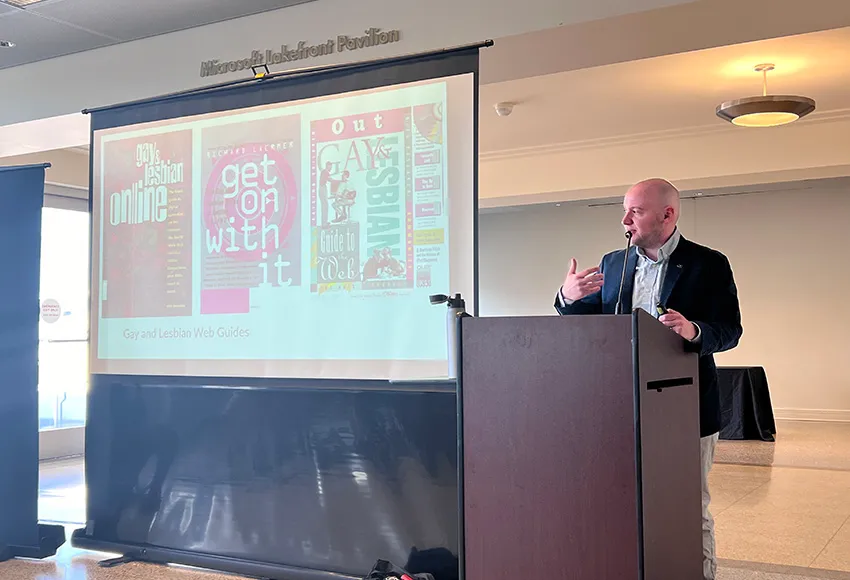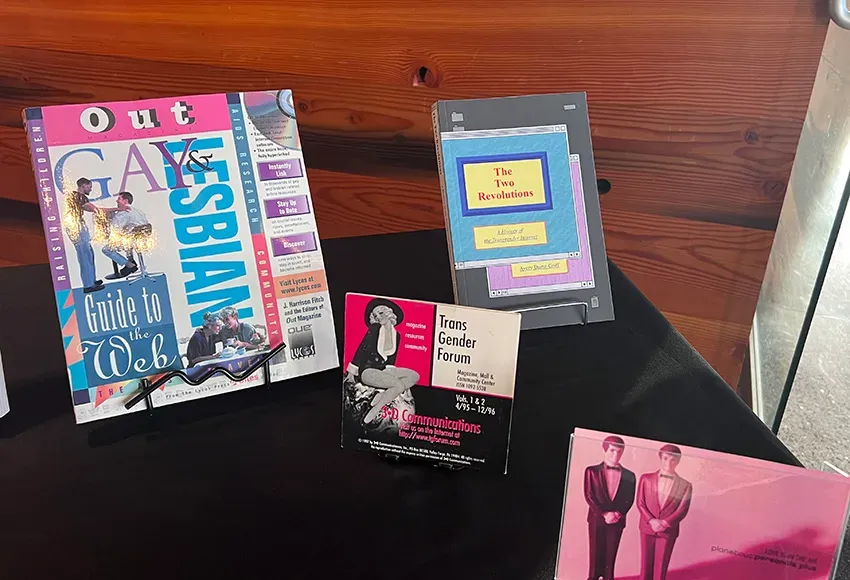On Wednesday, May 15, the Museum of History and Industry (MOHAI) hosted a talk called "History Café: Love and Modems," highlighting the impact of technology on the LGBT community. Dr. Avery Dame-Griff, a women, gender, and sexuality studies lecturer at Gonzaga University who has been studying the LGBT community and technology for more than a decade, hosted the talk.

While the history of the LGBT community and technology is expansive, Dame-Griff focused on the bulletin board system (BBS) usage in Washington State from the 1980s to the 1990s. Before mainstream internet use, BBSs were the easiest platforms the average user could access, a private, noncorporate system (that is, not managed by a bigger body, such as Meta).
This worked as follows: a user with a computer could use a modem to dial a phone number specific to the BBS, and a modem on the other end would pick up the call and log the user into the server. The user could now access chat rooms, files, games, etc.
So what did the social aspect of this type of online community mean for the Queer community?
28 Barbary Lane
There were two prominent BBS in the Seattle area for the Queer community, 28 Barbary Lane (28BBL) and the Seattle AIDS Information BBS (SAIBBS). 28BBL was founded in 1985 by the system's operator (or "sysop"), J.D. Brown, who was in the bar scene but soon tired of it, seeking other ways of connection for the Gay and Lesbian community. He learned about BBS and began to wonder if he could create one specifically for Gay and Lesbian people.
Brown advertised the BBS in the classifieds section of the Seattle Gay News. Soon enough, it became one of the most prominent Queer BBSs in the Seattle metro area. The name, 28 Barbary Lane, was a reference to a Queer book series, Tales of the City by Armistead Maupin.
"One important thing to know about bulletin board systems is that their users were often concentrated locally, because you're using a landline," Dame-Griff said. "This was back in the time of long-distance calling. If you long-distance called into a BBS, you were looking at an astronomical phone bill a month later."
People connected through 28BBL and began to have meetups, do fundraisers, organize politically, and connect through various forums. Many members made lifelong friends and even romantic connections.
28BBL had around a thousand members. The SGN covered it several times in its issues, and the BBS joined the Pride parade in 1993. In 1990, it won the best BBS in Washington state for the industry magazine Boardwatch.
Seattle AIDS Information
The Seattle AIDS Information BBS was founded by Steve Brown, a person with AIDS (PWA), in 1989, allowing other PWAs in the Seattle area free access to treatment news, lists of local resources, and an anonymous forum.
SAIBBS was converted into a nonprofit organization early on. BBSs were never moneymaking enterprises, so they constantly tried to raise funds, such as by becoming subscription-based. 28BBL even organized a fundraiser for SAIBBS to keep it afloat so that PWAs still had access to essential resources.
In the early 1990s, AIDS was still a very taboo topic, and so SAIBBS was sometimes the only resource people had. SAIBBS worked with nonprofits to donate computers to PWAs because, at the time, they were a considerable monetary investment.
Starting in 1995, the usage of BBSs began to dwindle, due to the creation of the World Wide Web, or the internet.
"On corporate platforms, their [Queer people's] presence could be more contingent on how the platform felt about the presence of adult material," Dame-Griff said. "This was especially pressing for Trans folk. BBSs allowed for these kinds of safe, niche community spaces."
Dame-Griff explained that since the person who ran the BBS was local, you would likely see that person at a meetup once a month. Members could complain directly to the sysop instead of filing a complaint through email to a corporation only to just sometimes get a response back. A BBS was more personal and not managed by a large corporation that determined what you could and couldn't post.
Dame-Griff discussed how we could see a non-corporate-run internet today; for some people, corporate platforms such as Facebook have always existed.
"This history tells us there's this whole kind of thing where you have an internet, a digital community, [that's] locally grounded," Dame-Griff said. "I hope some folks, the next time they hear about one of these alternative networks, they're not just like, 'Well, why would I do that?' and [instead] they're like 'Huh, maybe I should try it.'"
Dame-Griff ended the talk by asking people to open their minds to ways of using the internet that aren't owned by giant corporations and instead seek ways to connect online with people locally and personally.
The professor is continuing his research into BBSs and the Queer community and seeks Queer community members that were part of 28BBL and SAIBBS in the 1980s and 1990s. His email is [email protected]


